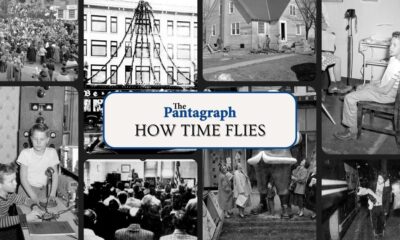Science
Acoustic Radiometer Innovator Pushes Boundaries of Sound Energy

A recent experiment has demonstrated a novel approach to powering a radiometer using acoustic energy rather than traditional light sources. Inventor Ben Krasnow constructed an acoustic radiometer that spins based on differences in sound pressure, showcasing the potential of sound waves in energy transfer applications.
The experiment involved creating two sets of vanes from laser-cut aluminium, with sound-absorbing foam affixed to one side. These vanes were mounted on a jewel bearing salvaged from an analog voltmeter and positioned above four speakers in a chamber designed to minimize acoustic leakage. By playing 130-decibel white noise through the speakers, Krasnow was able to create a pressure differential that caused the vanes to rotate.
Krasnow’s design capitalizes on the fact that the aluminium side of the vanes, which reflects sound more effectively, experiences greater sound pressure compared to the foam side. This difference in pressure results in the vanes spinning in opposite directions when tested with foam mounted on different sides, thus confirming that the rotation is indeed driven by acoustic pressure rather than other phenomena, such as acoustic streaming.
Innovative Techniques and Challenges
As with any ambitious project, Krasnow faced challenges during the experimentation phase. The high volume of sound generated led to several speakers burning out. To address this, he implemented a monitoring system for the temperature of the speaker coils. By tracking the resistance of the coils, which increases as they heat up, he was able to prevent overheating and extend the life of the speakers.
Krasnow also explored the performance of his radiometer in various gas environments, including hydrogen, helium, carbon dioxide, and sulfur hexafluoride. Surprisingly, these gases did not enhance performance compared to air. This counterintuitive result stems from the fact that speakers are primarily designed to transfer energy efficiently to air, indicating that air remains the optimal medium for this particular application.
Implications for Future Research
While the acoustic radiometer represents a fascinating exploration into sound energy, it is essential to note that this method is not the most efficient means of converting electrical power into motion. Nonetheless, it aligns with emerging research into engines powered by acoustic resonance, suggesting potential future applications in energy conversion technologies.
Krasnow’s work not only sheds light on the mechanics of the Crookes radiometer but also opens avenues for further investigation into the use of sound as an energy source. For those interested in the historical context, Krasnow has previously elaborated on the original Crookes radiometers, highlighting their operational principles and significance in the field of physics.
This innovative experiment by Ben Krasnow underscores the importance of creativity and experimentation in scientific inquiry, demonstrating how unconventional approaches can lead to new understandings and applications in energy science.
-

 Technology5 months ago
Technology5 months agoDiscover the Top 10 Calorie Counting Apps of 2025
-

 Technology2 weeks ago
Technology2 weeks agoOpenAI to Implement Age Verification for ChatGPT by December 2025
-

 Health3 months ago
Health3 months agoBella Hadid Shares Health Update After Treatment for Lyme Disease
-

 Health3 months ago
Health3 months agoAnalysts Project Stronger Growth for Apple’s iPhone 17 Lineup
-

 Health3 months ago
Health3 months agoErin Bates Shares Recovery Update Following Sepsis Complications
-

 Technology5 months ago
Technology5 months agoDiscover How to Reverse Image Search Using ChatGPT Effortlessly
-

 Technology3 months ago
Technology3 months agoElectric Moto Influencer Surronster Arrested in Tijuana
-

 Technology2 months ago
Technology2 months agoDiscover 2025’s Top GPUs for Exceptional 4K Gaming Performance
-

 Technology5 months ago
Technology5 months agoMeta Initiates $60B AI Data Center Expansion, Starting in Ohio
-

 Technology5 months ago
Technology5 months agoRecovering a Suspended TikTok Account: A Step-by-Step Guide
-

 Health5 months ago
Health5 months agoTested: Rab Firewall Mountain Jacket Survives Harsh Conditions
-

 Lifestyle5 months ago
Lifestyle5 months agoBelton Family Reunites After Daughter Survives Hill Country Floods





















